
Chenopodium album is a fast-growing annual plant in the flowering plant family Amaranthaceae. Though cultivated in some regions, the plant is elsewhere considered a weed. Common names include lamb's quarters, melde, goosefoot, wild spinach and fat-hen, though the latter two are also applied to other species of the genus Chenopodium, for which reason it is often distinguished as white goosefoot. Chenopodium album is extensively cultivated and consumed in Northern India, and Nepal as a food crop known as bathua.
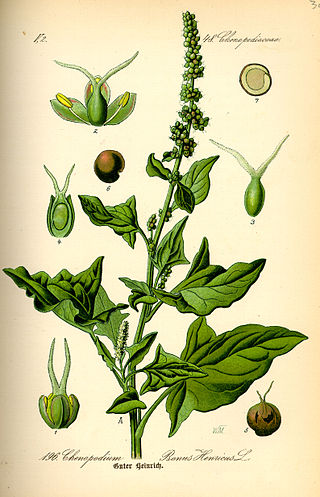
Blitum bonus-henricus, also called Good-King-Henry, poor-man's asparagus, perennial goosefoot, Lincolnshire spinach, Markery, English mercury, or mercury goosefoot, is a species of goosefoot which is native to much of central and southern Europe.

The Chenopodioideae are a subfamily of the flowering plant family Amaranthaceae in the APG III system, which is largely based on molecular phylogeny, but were included – together with other subfamilies – in the family Chenopodiaceae, or goosefoot family, in the Cronquist system.

Strawberry blite is an edible annual plant, also known as blite goosefoot, strawberry goosefoot, strawberry spinach, Indian paint, and Indian ink.

Chenopodium berlandieri, also known by the common names pitseed goosefoot, lamb's quarters, and huauzontle (Nahuatl) is an annual herbaceous plant in the family Amaranthaceae.
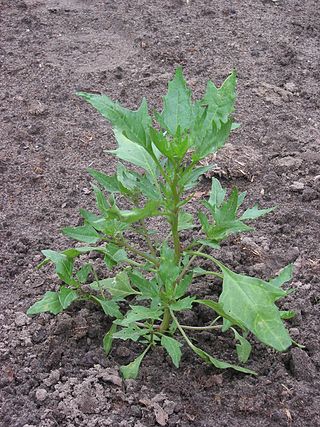
Oxybasis rubra, common names red goosefoot or coastblite goosefoot, is a member of the genus Oxybasis, a segregate of Chenopodium. It is native to North America and Eurasia. It is an annual plant.

Chenopodiastrum murale, is a species of plant in the family Amaranthaceae known by the common names nettle-leaved goosefoot, Australian-spinach, salt-green, and sowbane. This plant is native to Europe and parts of Asia and northern Africa, but it is widespread worldwide, particularly in tropical and subtropical areas due to the ease of it being introduced. It is a common weed of fields and roadsides.
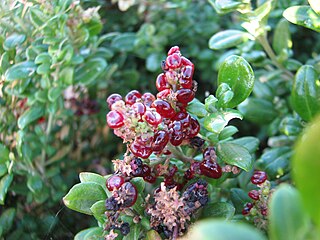
Chenopodium candolleanum, commonly known as seaberry saltbush, is a shrub in the subfamily Chenopodioideae of the family Amaranthaceae, native to Australia.
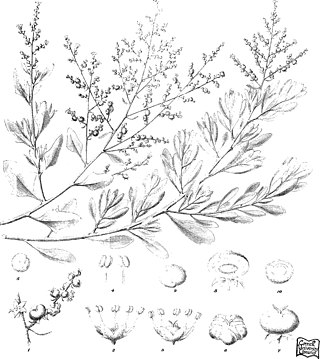
Chenopodium baccatum, commonly known as berry saltbush, is a species of shrub endemic to Western Australia.

Blitum virgatum, is a species of flowering plant in the amaranth family known by the common name leafy goosefoot. It is native to Eurasia. It can be found on other continents as an introduced species, growing as a minor weed in disturbed habitats and cultivated land.

Blitum californicum is a species of flowering plant in the amaranth family known by the common names California goosefoot and (ambiguously) "Indian lettuce".

Oxybasis chenopodioides is a species of flowering plant in the family Amaranthaceae known by the common name saltmarsh goosefoot. It is native to Europe, Asia and parts of Africa, where it grows on bare mud in brackish hollows in coastal grassland, inland salt steppes and salty deserts. It has spread to similar habitats in both North and South America. Its habitat is an uncommon one and is threatened by agricultural improvement in many areas, but overall its populations are stable. This species often grows with, and is easily confused with the closely-related red goosefoot.

Blitum nuttallianum, is a species of flowering plant in the amaranth family known by the common names povertyweed and Nuttall's povertyweed. It is native to North America, where it is widespread and common from Alaska to Mexico to New England. It can be found in many types of habitat, including disturbed areas, often favoring wet places. It is a fleshy annual herb producing two or more erect, reddish, hairless stems up to about 40 centimeters tall. The thick lance-shaped or arrowhead-shaped leaves are up to 4 centimeters in length. Clusters of several rounded flowers each appear in the leaf axils and yield small fruits about 2 millimeters wide.
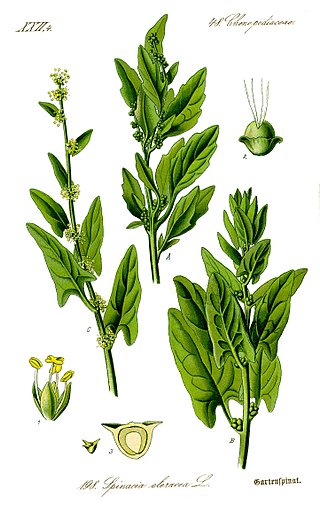
Spinacia is a flowering plant genus in the subfamily Chenopodioideae of the family Amaranthaceae. The most common member is spinach.

Dysphania is a genus of plants in the family Amaranthaceae. Species of the genus are found worldwide from the tropics and subtropics to warm-temperate regions.

Oxybasis glauca, common name oak-leaved goosefoot, is a species of goosefoot plant native to Europe. It has been introduced and become an invasive weed in North America. This invader of European origin also appears in trampled communities in North Korea.

Chenopodiastrum is a genus of herbaceous flowering plants in the family Amaranthaceae. The genus was formally described in 2012. The 5 species occur in Eurasia, North Africa, and North America.

Blitum is a genus of flowering plants in the amaranth family Amaranthaceae, subfamily Chenopodioideae. It is closely related to genus Spinacia. Its 12 species were traditionally placed in the genera Chenopodium, Monolepis, or Scleroblitum. The species of genus Blitum occur in Asia, Europe, North Africa, the Americas, and Australia.
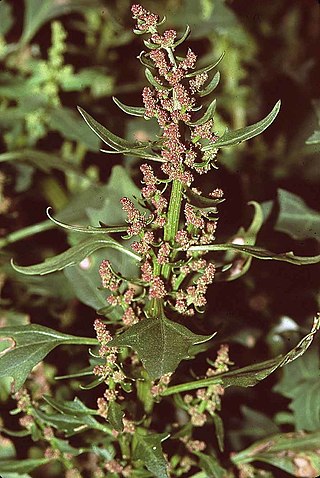
Oxybasis is a flowering plant genus from the subfamily Chenopodioideae of the family Amaranthaceae. It was first described in 1841, and newly used since 2012 for five species that were traditionally grouped into genus Chenopodium. They occur in Europe, Asia, North Africa and America.

Lipandra polysperma, common name manyseed goosefoot, is the only species of the monotypic plant genus Lipandra from the subfamily Chenopodioideae of the family Amaranthaceae.






















